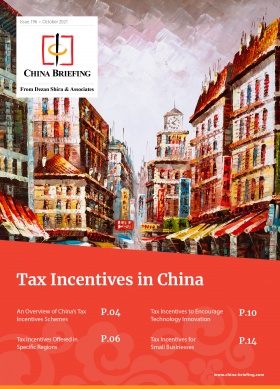2022 Import-Export Taxes and Duties in China
This article was originally published in March 2013. It was last updated on December 22, 2021.
- This article explains three types of taxes – value-added tax (VAT), consumption tax, and customs duties – that foreign companies exporting to or importing from China must understand.
- Starting January 1, 2022, China has further adjusted parts of its customs duties, including most-favored-nation (MFN) duty rates, conventional duty rates, and provisional duty rates for some import products. Read the section on customs duties in this article for more information.
China has promulgated a series of regulations to reduce import-export taxes and duties to promote a higher level of openness and domestic consumption. These changes could affect companies that import and export taxable goods and services with China.
Governing this intricate system is a central list of general principles for foreign companies to abide by. Below, we explain the three types of taxes applicable to companies importing products from or exporting products to China – Value-added tax (VAT), consumption tax (CT), and customs duties, and outline the most significant issues relating to these taxes and duties that foreign companies should take note of.
Value-added tax for imported goods
From April 1, 2019, China’s import VAT on imported goods has been lowered to either 9 percent or 13 percent, down from the previous 10 percent or 16 percent, according to the Announcement of the State Taxation Administration (STA) on Deepening the Reform of VAT (STA Announcement [2019] No.39).
The 9 percent tax is available for certain goods that fall mainly within the categories of agricultural and utility items, while the 13 percent tax applies to other goods subject to the VAT like manufactured goods.
Taxable services provided by foreign entities or individuals in China are subject to 6 percent of VAT as before.
The import VAT can be calculated based on the following formula:
Import VAT = Composite Assessable Price × VAT Rate
= (Duty-Paid Price + Import Duty + Consumption Tax) × VAT Rate
= (Duty-Paid Price + Import Duty) / (1-Consumption Tax Rate) × VAT Rate
Consumption tax for imported goods
China’s consumption tax (CT) is imposed on companies and organizations that manufacture and import taxable products, process taxable products under consignment, or sell taxable products.
Imported products taxable under China’s consumption tax include those that are harmful to one’s health like tobacco or alcohol, luxury goods like jewelry and cosmetics, and high-end products, such as passenger cars and motorcycles.
For imported goods, the consumption tax rate varies depending on the type of product being brought into the country.
Calculating consumption tax can be done by using either the ad valorem method, quantity-based method, or the compound tax method. The formulas to compute the consumption tax are as follows:
- Ad valorem method
Consumption Tax Payable = Taxable Sales Amount × Tax Rate
- Quantity-based method
Consumption Tax Payable = Taxable Sales Quantity × Tax Amount per Unit
- Compound tax method
Consumption Tax Payable = Taxable Sales Amount × Tax Rate + Taxable Sales Quantity × Tax Amount per Unit
Customs duties
Customs duties include import and export duties.
Customs duty rates on imports include most-favored-nation (MFN) duty rates, conventional duty rates, special preferential duty rates, tariff rate quota (TRQ) duty rates, general duty rates, and provisional duty rates for imports that may be implemented for a specified period of time.
Customs duty rates on exports are set with one type. But likewise, there might also be provisional duty rates for exports that can be implemented for a specified period of time.
From January 1, 2022, a total of 8,930 imported items and 106 exported items will be taxed in China, according to the 2022 Tariff Adjustment Plan (Tariff Commission Announcement [2021] No.18).
Import duties
Customs duty rates on import goods consist of:
- Most-favored-nation duty (MFN) rates;
- Conventional duty rates;
- Special preferential duty rates;
- Tariff rate quota (TRQ) duty rates;
- General duty rates; and
- Provisional duty rates.
MFN duty rates
MFN duty rates apply to the following goods imported to China:
- Imports originating from WTO member countries that apply the MFN treatment clause;
- Imports originating from countries or territories that have concluded bilateral trade agreements containing provisions on MFN treatment with China; and
- Imports originating from China.
MFN duty rates are the most commonly adopted import duty rates. They are much lower than the general rates, which apply to non-MFN nations.
Starting January 1, 2022, China will adopt provisional duty rates on a total of 954 imported commodities that were subject to the default MFN duties – the provisional duty rates are lower than the MFN tariffs.
Among them, some anti-cancer drugs, medical products, aquatic products, sports equipment, oil paintings and antique artwork, high-efficiency auto parts, materials for environmental restoration, and mineral resources will enjoy lower tariff rates.
Besides, China has scrapped provisional duty rates and resumed the MFN duty rates on some amino acids, lead-acid battery parts, gelatin, pork, and m-cresol.
In addition, from July 1, 2022, MFN duty rates on 62 IT products will be further been trimmed, including on medical diagnosis machines, signal generators, and parts of speakers and printers.
Conventional duty rates
Conventional duty rates are applied to imported goods that originate from countries or territories that have entered into regional trade agreements containing preferential provisions on duty rates with China.
So far, China has signed 19 bilateral or multilateral free trade agreements with more than 29 countries or regions. Imported goods originating in these countries and regions will be subject to conventional duty rates, which is normally lower than the MFN duty rates.
From January 1, 2022, China will apply conventional duty rates on products from 29 countries.
Bilateral FTAs between China and New Zealand, Peru, Costa Rica, Switzerland, Iceland, South Korea, Australia, Pakistan, Georgia, and Mauritius, as well as Asia-Pacific Trade Agreement (APTA), will further reduce conventional duty rates on certain products originating from the contracting countries.
The RCEP and the China-Cambodia FTA will enter into force on January 1, 2022, which will also trigger tariff reductions.
Also, except for the products to which mainland China has made special commitments in relevant international agreements, zero tariffs will be applied to all products originating in Hong Kong and Macao.
Special preferential duty rates
Special preferential duty rates are applied to imported goods originating from countries or territories with trade agreements containing special preferential duty provisions with China. They are generally lower than MFN rates and conventional duty rates.
Tariff rate quota duty rates
China’s tariff rate quota (TRQ) rates apply to eight categories of goods: wheat, corn, rice, sugar, wool, cotton, and fertilizer.
Under tariff rate quota (TRQ) schemes, goods imported within the quota are subject to a lower tariff rate, and goods imported beyond the quota are subject to higher duty rates.
For example, the TRQ rate for importing wheat products within the quota is as low as 1, 6, 9, or 10 percent – substantially lower than the MFN duty rate of 65 percent and the general duty rate of as high as 130 percent or 180 percent.
General duty rates
General duty rates apply to imported goods originating from countries or territories that are not covered in any agreements or treaties or are of unknown places of origin.
Provisional duty rates
China usually updates provisional duty rates for certain imported goods annually in order to boost imports and meet domestic demand.
Where there is a provisional duty rate for the imported goods to which MFN tariff rate is applicable, the provisional duty rate should apply. Where provisional rates are applicable for imports on which conventional or special preferential duty rates apply, the lower of the applicable rates should apply. Provisional rates do not apply for imports subject to the general tariff.
Export duties
Export duties are only imposed on a few resource products and semi-manufactured goods.
From January 1, 2022, China continues to impose export tariffs or impose provisional export duties on 106 export commodities with fixed and unchanged tax rates.
Other duty rates
Considerably higher rates may be implemented according to Chinese regulations regarding dumping, anti-subsidies, and safeguard measures. Retaliatory tariffs could also be applied to goods originating from countries or regions that violate trade agreements.
Over the course of the US-China trade war, China has imposed retaliatory tariffs on US$185 billion worth of US goods, including beef, lamb, pork, vegetables, juice, cooking oil, tea, coffee, refrigerators, and furniture, among many other items.
Duty relief for key technical equipment
At the end of 2021, China has released the Catalogue of State-supported Key Technical Equipment and Products (2021 version), the Catalogue of Imported Key Components and Raw Materials of Key Technical Equipment and Products (2021 version), and the Catalogue of Imported Major Technical Equipment and Products Not Exempted from the Duties (2021 version) which will take effect on January 1, 2022.
Importing certain key components and raw materials or exporting certain key technical equipment and products listed in the catalogue to eligible Chinese domestic enterprises is exempt from import VAT and customs duties.
Duty paying value for imported goods
The amount of import taxes and customs duty payable is calculated based on the price or value of the imported goods. This value is called the duty paying value (DPV).
The DPV is determined based on the transacted price of the goods – that is, the actual price directly and indirectly paid or payable by the domestic buyer to the foreign seller, with certain required adjustments.
DPV includes transportation-related expenses and insurance premiums on the goods prior to unloading at the place of arrival in China. Import duties and taxes collected by customs are excluded from DPV.
Calculating import–export taxes and duties payable
Import taxes and duties payable can be calculated after determining the DPV and the tax and tariff rates of the goods. The formulae are:
Import duties
Import taxes and duties payable can be calculated after determining the DPV and the tax and tariff rates of the goods. Similar to consumption tax, customs duties are also computed either on an ad valorem basis, quantity basis, or compound formula. The formulas are:
- Ad valorem basis:
Duty payable = DPV x Tariff rate
- Quantity-based:
Duty payable = Quantity of imported goods x Amount of duty per unit
- Compound formula:
Duty payable = DPV x Tariff rate + Quantity of imported goods x Amount of duty per unit
Import taxes and duty payable should be calculated in RMB using the benchmark exchange rate published by the People’s Bank of China.
Export duties
The tax base for export duties is the same as import duties – that is, the DPV.
The DPV for export duties is based on the transacted price, that is, the lump sum price receivable by the domestic seller exporting the goods to the buyer.
Export duties, freight-related expenses, and insurance fees after loading at the export spot, and commissions borne by the seller, are excluded.
About Us
China Briefing is written and produced by Dezan Shira & Associates. The practice assists foreign investors into China and has done so since 1992 through offices in Beijing, Tianjin, Dalian, Qingdao, Shanghai, Hangzhou, Ningbo, Suzhou, Guangzhou, Dongguan, Zhongshan, Shenzhen, and Hong Kong. Please contact the firm for assistance in China at china@dezshira.com.
We also maintain offices assisting foreign investors in Vietnam, Indonesia, Singapore, The Philippines, Malaysia, Thailand, United States, and Italy, in addition to our practices in India and Russia and our trade research facilities along the Belt & Road Initiative.
- Previous Article Fujian Pingtan Extends 15% CIT for Qualified Enterprises Until End of 2025
- Next Article Investing in Tianjin: China City Spotlight







